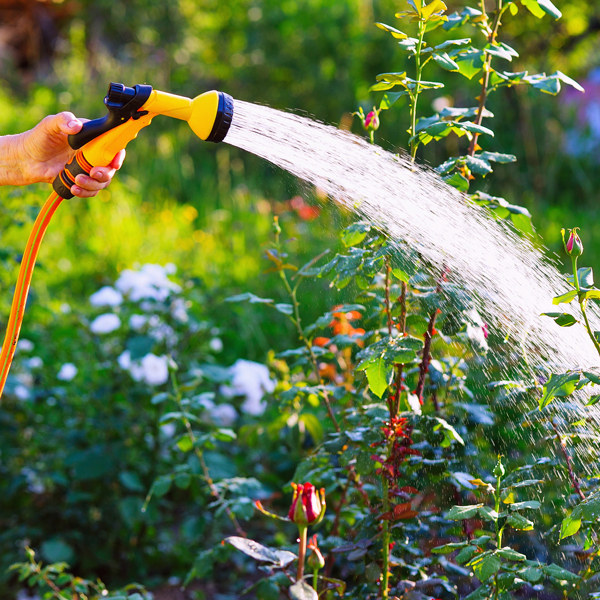
We spend a lot of time watering our plants here at Weston Nurseries, so you could say that we know a thing or two about irrigation. Just about every staff member here has spent significant time with a sprinkler hose, standing around in soggy sneakers while contemplating pots and roots and soil moisture. You get to know your plants really well when you spend time standing there watering them…. and that’s a very good thing for any gardener.
Of course summer is always tough because of drought and water restrictions. Quick summer thunder showers — even with brief heavy rainfalls — do not usually soak far enough into the ground to do a complete watering job. For newly installed plants it’s particularly crucial to not only water them enough, but to water them correctly.
So- are you watering your plants the right way? Here are the key principles of proper watering:
Water Deeply. Train your plants to grow strong, healthy root systems which delve deep into the soil by giving them a regular deep soaking. This will help them become more resilient to periods of drought in the long run.
When hand watering established perennials, ground covers or very small shrubs, use a hose-end nozzle with a shower setting and spray in broad strokes to dampen the surface, and then go back and water deeply right in the area around the roots and outward. Stand there and count to thirty. Repeat this 3-5 times. For established shrubs and trees, you may need to repeat this a few more times because the root system is deeper. For new plantings, please follow our watering guidelines. www.westonnurseries.com/watering

Even better, use a soaker hose with a timer to save yourself time and conserve water – this is a really great solution if you plan on leaving for vacation. It’s really smart to use a soaker hose for new tree & shrub plantings, annuals, vegetables, perennials, and plants that need some extra TLC.
Water Frequently. Happy successful plants get a good soaking regularly, either from natural rainfall or from well organized irrigation. There’s lots of methods to figure out when you really need to water, but the rule of thumb is to make sure your plants are getting at least 1 inch of water per week.
Use a rain gauge or a weather app on your phone to keep track of weekly precipitation, or if you’re feeling really technical you can use a moisture meter. Nothing beats sticking your finger in the soil to check for moisture- cool and damp is ok, but warm and crumbly means it’s time to crank the hoses.
…But don’t water too frequently! Just like you and me, the soil needs to breathe. Let the soil dry out between waterings so that the roots have a chance to shed carbon dioxide.
A note about sprinkler systems. They’re usually fine for established lawns and flowerbeds, always fun for a barefoot summer romp to cool off, and very convenient when they’re set up on a timer. However, they can be a tremendous waste of water and are not always effective. For new plantings done within the last year your sprinkler is really not enough!
Got questions? We’re always happy to help, or demonstrate our masterful sprinkler techniques first hand here at the garden center (someone will be watering something, somewhere). We have plenty of hoses, sprayers, sprinklers, and supplies that can help you save water and keep your plants looking lush and lovely all summer long!









